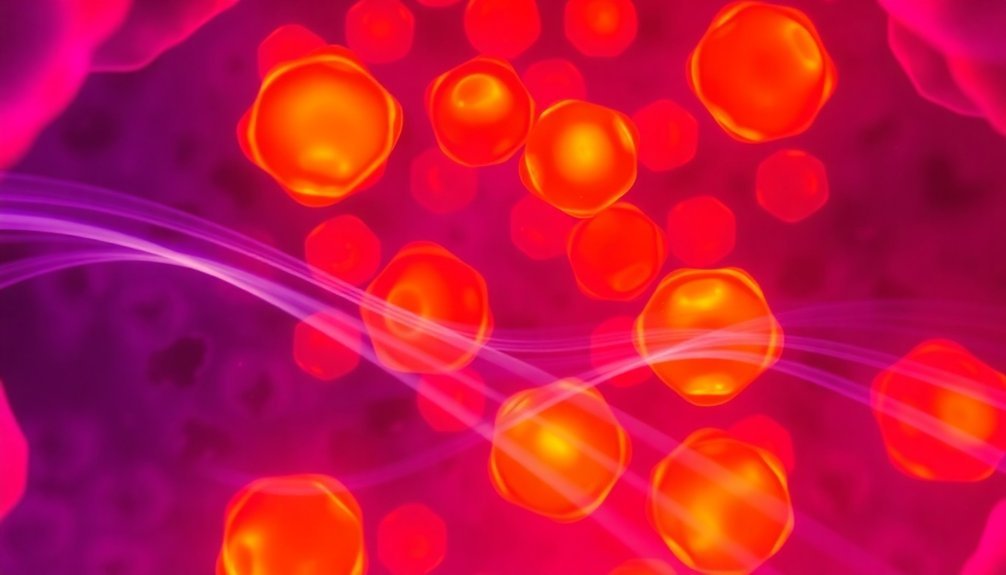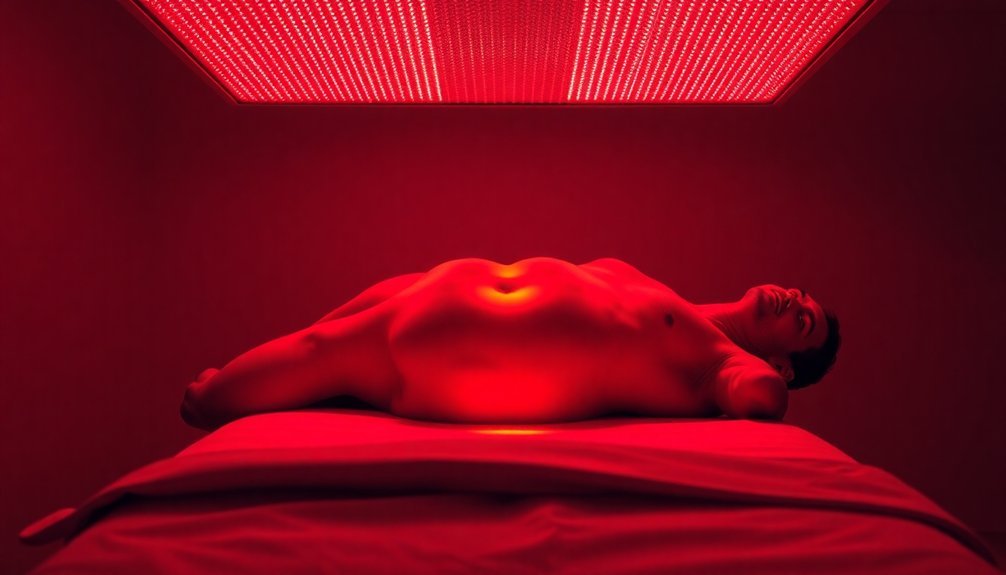Near-infrared light can boost your male hormone production in several key ways. It enhances mitochondrial function in Leydig cells, increasing ATP production needed for testosterone synthesis. The deep penetration of specific wavelengths (670-830nm) improves cellular energy throughout reproductive tissues. You'll benefit from increased blood flow and nitric oxide release, supporting hormone transport and synthesis. Infrared also helps reduce oxidative stress that can impair testosterone production. While direct gonadal application isn't recommended, systemic exposure through targeted areas like abdomen and back may support your hormonal health. Understanding these mechanisms reveals powerful opportunities for natural optimization.
Cellular Energy and Testosterone Production

Deep within the powerhouses of male reproductive cells, mitochondria play a vital role in testosterone production. These microscopic structures in your Leydig cells orchestrate the complex process of hormone synthesis through a protein called Atp5a1.
When your mitochondria function effectively, they maintain the necessary cellular energy for testosterone production.
Your body's testosterone production depends on several key enzymes, including StAR, CYP11A1, and 17β-HSD. These enzymes work together in a carefully coordinated network, but they can't function properly if your mitochondria are damaged. To make an accurate diagnosis, total testosterone levels should be measured twice in the early morning, at least 2-3 weeks apart.
Chronic stress can particularly harm your mitochondrial function, disrupting this delicate system and reducing testosterone output.
You'll find testosterone's influence extends far beyond hormone production – it's essential for your body's metabolism of carbohydrates, fats, and proteins. When your testosterone levels drop, you're more likely to experience increased body fat, reduced insulin sensitivity, and poor glucose tolerance.
These metabolic changes can create a negative cycle, as obesity and insulin resistance can further suppress testosterone production through elevated leptin levels and disrupted hormonal signaling.
Understanding this connection between cellular energy and testosterone production helps explain why maintaining healthy mitochondrial function is vital for effective hormone levels.
Deep Tissue Light Penetration
Three key wavelength ranges determine how effectively infrared light penetrates your body's tissues. The therapeutic window of 700-1000nm offers the best penetration, while wavelengths below 700nm face increased hemoglobin absorption, and those above 950nm encounter water absorption that can cause heating.
You'll get the deepest penetration using near-infrared light in the 720-840nm range. This wavelength range helps boost cellular energy by enhancing ATP production in mitochondria throughout the deeper tissues.
When you're targeting male hormone production, specific wavelengths matter considerably. Red light at 670nm has proven particularly effective for reproductive health and sperm quality, while near-infrared at 830nm penetrates deeper into tissues.
You don't need to worry if the light doesn't directly reach all targeted tissues – your body responds systemically to the treatment.
These systemic effects work through your blood and stem cells, creating benefits that extend beyond the direct penetration depth. Dr. Hamblin's research shows that when light therapy triggers increased ATP production and NO release in exposed tissues, it creates a cascade of positive effects throughout your body.
To enhance your results, you'll want to combine both direct targeting and systemic approaches, using appropriate wavelengths and intensities that avoid skin damage while maximizing therapeutic benefits.
Leydig Cell Stimulation Methods

Understanding Leydig cell stimulation begins with the critical role of luteinizing hormone (LH) in testosterone production. When LH binds to receptors on Leydig cells, it triggers a cascade of molecular events that boost testosterone synthesis. This process primarily works through cAMP-dependent pathways, where protein kinase A activation leads to increased steroidogenesis. Oxidative stress can significantly impact testosterone production, as increased free radicals can impair Leydig cell function.
You can't overlook the importance of other signaling mechanisms in Leydig cells. Besides cAMP, calcium signaling and ERK1/2 phosphorylation play vital roles in hormone production.
The STAR protein, which helps transport cholesterol into mitochondria, becomes more active when stimulated by LH. You'll also see increased activity of key enzymes like CYP11A1, HSD17B3, and CYP17A1, all essential for testosterone synthesis.
Various growth factors can enhance Leydig cell function. Both FGF9 and EGF have been shown to boost testosterone production and STAR protein levels.
However, you should know that aging can impact these processes, leading to reduced cAMP production and decreased steroidogenesis. This decline partly occurs due to receptor desensitization and increased phosphodiesterase activity, which breaks down cAMP.
Wavelength Selection for Hormone Optimization
When selecting wavelengths for hormone optimization, you'll need to focus on the near-infrared spectroscopy (NIRS) range between 780 nm and 2500 nm. For ideal results, you'll want to pair shorter wavelengths with longer ones, such as 692 nm with 830 nm, to achieve better sensitivity in measuring hormone levels.
| Parameter | Impact | Optimization Method |
|---|---|---|
| Absorption Level | Affects signal quality | AVO-PLS algorithm |
| Signal-to-Noise | Determines accuracy | Wavelength pairing |
| Wavelength Range | Influences sensitivity | SPA selection |
| Model Performance | Controls reliability | PLS evaluation |
You'll need to avoid both high absorption wavebands that create noise and low absorption wavebands that lack sufficient information. Using algorithms like AVO-PLS and SPA can help you select the most effective wavelengths for hormone analysis. These tools enhance the upper and lower bounds of absorbance while maintaining strong signal-to-noise ratios. For optimal readability of wavelength data, maintain parallel phrasing throughout your measurements and analysis.
Remember that selecting too few wavelengths can decrease your model's performance. You'll achieve the best results by balancing the number of wavelengths with your analysis needs, ensuring consistent formatting and reliable hormone measurement outcomes.
Direct Gonadal Light Application

Research investigating direct gonadal light application for hormone production remains largely unexplored territory in clinical studies. While it's acknowledged that hormone production relies on the hypothalamic-pituitary-gonadal axis, there's no concrete evidence linking infrared light exposure to increased testosterone or other male hormone production.
Hormone regulation depends on complex feedback mechanisms, with GnRH stimulating LH and FSH production, which then triggers testosterone production in Leydig cells. However, this process isn't directly influenced by external light sources.
While photobiomodulation can affect cellular processes through energy transfer, its impact on gonadal hormone production hasn't been documented.
If you're considering direct gonadal light application, you should know that current clinical approaches focus on pharmacological interventions rather than light therapy. Standard hormone therapy protocols aim to achieve physiological male-range levels through medication, not light exposure.
The lack of experimental studies on direct gonadal light application makes it impossible to draw conclusions about its effectiveness. Your hormone production is primarily controlled by intricate internal feedback loops that operate independently of external light influences.
Frequently Asked Questions
Can Infrared Therapy Interact Negatively With Existing Hormone Replacement Treatments?
You should know that infrared therapy can potentially interact with your hormone replacement treatments. While it's generally safe, you'll need your doctor's supervision to monitor any adverse effects during combined therapy.
How Long Should Breaks Be Between Red Light Therapy Sessions?
You'll need several hours between red light therapy sessions. For the best results, space your treatments by at least 4-6 hours. If you're doing daily sessions, stick to 2-5 minutes per session.
Does Wearing Clothing During Treatment Reduce the Effectiveness of Infrared Therapy?
Yes, wearing clothes will reduce infrared therapy's effectiveness. Your clothing creates a barrier that blocks or absorbs the radiation before it reaches your skin. For best results, you'll want direct skin exposure to the infrared.
Are There Age Restrictions for Using Infrared Therapy for Hormone Optimization?
You won't face specific age restrictions for infrared therapy's hormone benefits, but you should consult your healthcare provider first. It's generally safe for all ages when used properly under medical guidance.
Can Infrared Therapy Help With Post-Cycle Hormone Recovery in Athletes?
While infrared therapy can't replace proper post-cycle therapy, it may support your hormone recovery by reducing stress, improving metabolism, and enhancing overall recovery. However, you'll still need traditional PCT protocols for steroid recovery.
In Summary
You'll find that infrared therapy offers a promising path to optimize your male hormone production naturally. By applying specific wavelengths and targeting key cellular mechanisms, you're able to enhance testosterone levels through improved Leydig cell function and cellular energy production. Whether you're using localized treatment or full-body exposure, you're tapping into light's powerful ability to stimulate and regulate your endocrine system.





Leave a Reply